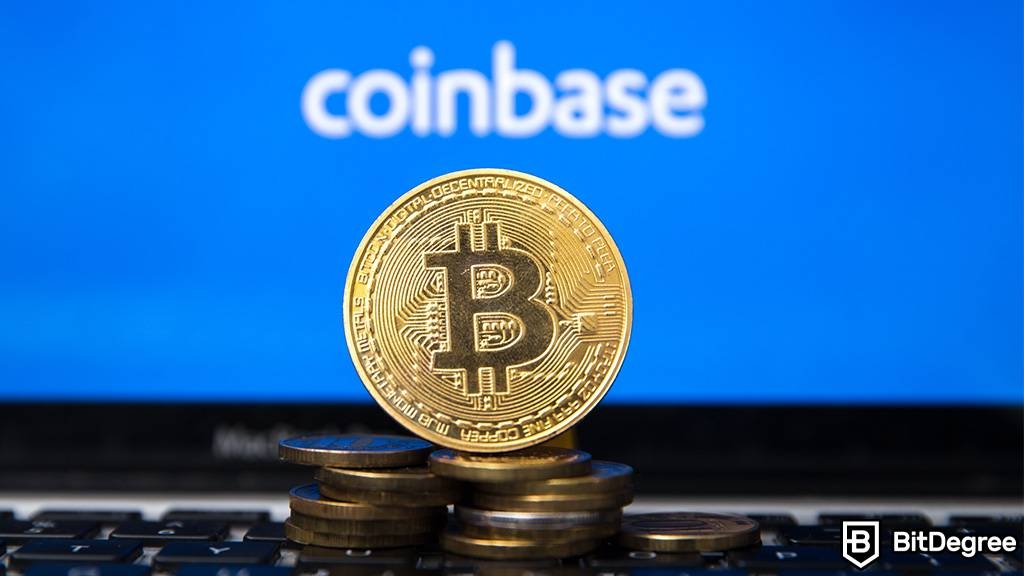Stop overpaying - start transferring money with Ogvio. Sign up, invite friends & grab Rewards now! 🎁
Cryptocurrencies have revolutionized the finance world, offering new ways to invest, spend, and store value. Nowadays, one of the most popular ways to earn passive income using crypto is staking (and it has been available since 2012!). Despite the fact that staking can be a little challenging, this guide on how to stake on Coinbase will make it easy for you!
If you’re not completely new to the crypto world, you must have heard about Coinbase. But can you stake on Coinbase? The answer is pretty obvious – of course, you can! In fact, Coinbase is considered one of the best options available for staking!
Overall, Coinbase is one of the most popular crypto platforms on the market and is also one of the largest and most trusted cryptocurrency exchanges. It provides a large selection of coins that can be staked in addition to alluring staking rewards.
So, let me walk you through everything you need to know about how to stake on Coinbase. Whether you're a seasoned crypto investor or just a newbie starting out, this guide will provide all the information you need to use the Coinbase platform for staking. You'll be able to start staking your assets and earning Coinbase staking rewards in no time.
Now, let's dive in and explore the exciting world of staking!

Did you know?
Subscribe - We publish new crypto explainer videos every week!
4 Ways to Turn Fiat to Crypto VS Crypto to Fiat (Easily Explained)


Table of Contents
- 1. What is Staking?
- 2. Why Stake on Coinbase?
- 3. Now That That’s Settled, Let’s Choose the Right Coin
- 3.1. What Coins Can You Stake on Coinbase?
- 3.2. Things to Consider When Choosing the Right Coin
- 4. How to Stake on Coinbase?
- 4.1. Minimum Requirements for Staking on Coinbase
- 4.2. Step-By-Step Guide on How to Stake on Coinbase
- 5. What About Coinbase Pro Staking?
- 6. Risks and Rewards of Staking on Coinbase
- 7. Conclusions
What is Staking?
Even though this article is about how to stake on Coinbase, we need to cover the basics first: So, what is staking?
Latest Deal Active Right Now:Staking is a process where you hold a certain amount of cryptocurrency in a wallet to support the operations of a blockchain network. Overall, long-term cryptocurrency holders often view staking as a means of putting their assets to work. How? Well, staked assets generate rewards instead of sitting idly in their wallets.
Yes, that’s right, you can earn staking rewards in the form of additional coins or tokens.
Think of staking as depositing money in a savings account at a bank. When you stake your coins, you essentially lend them to the blockchain network, which uses them to verify transactions and create new blocks. In return, you earn staking rewards, similar to the interest you earn on a savings account.
Speaking of crypto wallets, Coinbase has its own crypto wallet. Though, if you're searching for a more secure way to store your crypto assets, make sure to check out Ledger Nano X. It is, after all, one of the most secure hardware wallets! Besides, it can be connected to the Coinbase wallet.
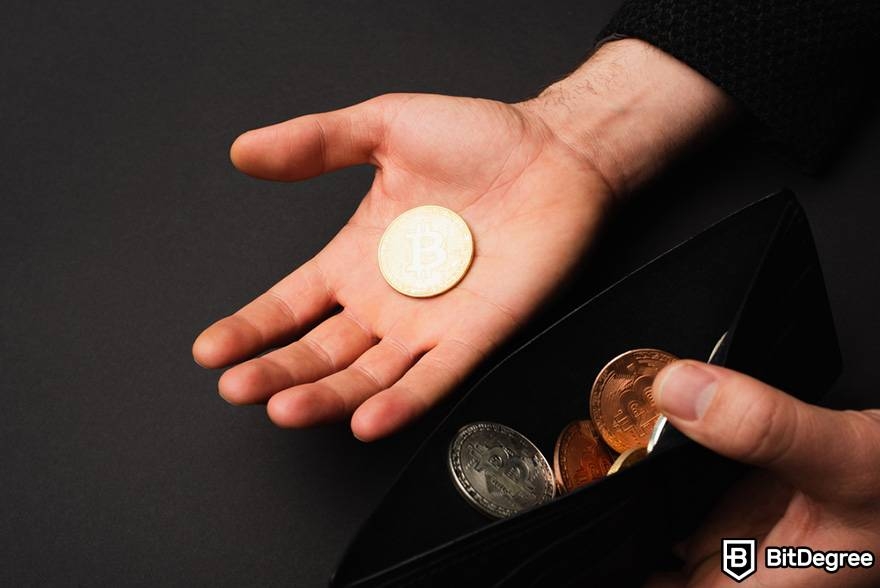
Now, getting back to staking, note that it is an important part of many Proof-of-Stake (PoS) blockchains. Besides, it helps to ensure the network's security and efficiency.
On a PoS blockchain, stakers are chosen to validate transactions based on the amount of cryptocurrency they hold. This means that the more cryptocurrency you stake, the higher your chances are of being selected to validate transactions and earn rewards.
As a staker, you also have a financial stake in the network's performance, which motivates you to help keep the network secure and efficient.
Perhaps, you're already familiar with the process of mining? Then, all you need to understand is that in Proof-of-Stake (PoS) blockchains, the validator gets a reward if the node with your staked assets successfully generates a block. Thus, it works similarly to how a miner is rewarded in Proof-of-Work (PoW) chains when they successfully solve mathematical puzzles.
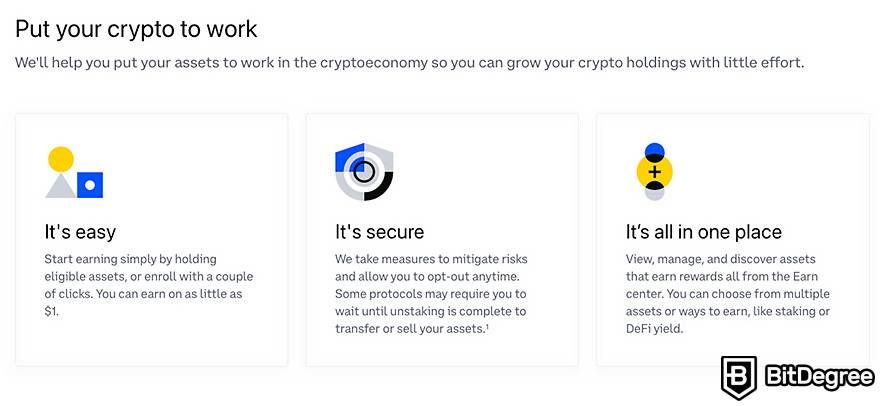
So, now you know what staking is overall. However, what is staking on Coinbase (or other similar platforms)? In a nutshell, it's a simple method for earning rewards from your cryptocurrency holdings without navigating the challenging process of staking directly on the blockchain.
To start staking on Coinbase, you'll first need to hold a cryptocurrency you want to stake in your wallet. As of writing, Coinbase supports staking for several cryptocurrencies, including Ethereum, Cardano, and Cosmos. However, we’ll talk more about supported coins later. Now, it's also important to talk about why you should stake on Coinbase.
Why Stake on Coinbase?
Before getting to the "how to stake on Coinbase" part, let me tell you why you should choose this platform! Coinbase surely is a well-known and trusted cryptocurrency exchange that makes it really easy for users to stake their crypto holdings.
By staking on Coinbase, you can earn staking rewards without going through the hassle of managing your own nodes or setting up complicated staking processes.
So, one of the key advantages of using Coinbase’s staking system is that it's a straightforward and user-friendly process. You don't need to have any technical expertise or specialized knowledge to start your Coinbase staking journey.
The platform guides you through the process step-by-step and provides clear instructions for each supported cryptocurrency.

Another advantage of staking on Coinbase is that it's a secure and reliable platform. Coinbase puts a lot of effort into its robust security system to protect user funds and personal information from hackers and other cyber threats.
The platform also has a strong reputation in the cryptocurrency community and is known for its transparency, integrity, and commitment to customer satisfaction.
Last but not least, Coinbase allows you to stake a variety of well-known cryptocurrencies, which I'll go over later.
To sum up, Coinbase offers a simple and secure way to earn rewards from multiple cryptocurrencies, diversify your portfolio, and potentially increase your earnings even more. With the staking rewards offered by Coinbase, you’ll never worry about your funds just sitting there.
Besides all those benefits, the platform also provides clear instructions on how to stake on Coinbase for each supported cryptocurrency, making the process easy for beginners and experts alike.
Now That That’s Settled, Let’s Choose the Right Coin
When thinking about how to stake on Coinbase, the first step is asking the question, “what coins can you stake on Coinbase?” Since Coinbase supports many different cryptocurrencies, doing research on them is very important. By researching and choosing the right coin to stake, you can maximize rewards and minimize risks.
While you always must do your own research, let me save you the hassle this time.
What Coins Can You Stake on Coinbase?
As of writing, on Coinbase, you can stake such assets as Ethereum (ETH), Solana (SOL), Cardano (ADA), Cosmos (ATOM), and Tezos (XTZ). The table below shows all the ins and outs of staking these assets on Coinbase.
Crypto asset | What is the required minimum balance? | What is the standard commission taken by Coinbase? | How often are rewards paid out? | What is the length of the unstaking period? | What is the length of the unstaking processing time? |
Ethereum (ETH) | None | 25% (15% for Coinbase One members) | Every 3 days | Minimum 27 hours (could be more if the demand is high) | Maximum 48 hours |
Solana (SOL) | $1 worth of SOL | 35% (26.3% for Coinbase One members) | Every 3 days | 3 days | Maximum 48 hours |
Tezos (XTZ) | 0.0001 XTZ | 25% (15% for Coinbase One members) | Every 3 days | None | Maximum 48 hours |
Cardano (ADA) | $1 worth of ADA | 35% (26.3% for Coinbase One members) | Every 5 days | None | Maximum 48 hours |
Cosmos (ATOM) | 0.0001 ATOM | 25% (15% for Coinbase One members) | Every 7 days | 21 days | Maximum 48 hours |
Table: ETH, SOL, XTZ, ADA, and ATOM staking on Coinbase information
Now, what should you know about these assets overall?
- Ethereum is one of the largest cryptocurrencies in terms of market capitalization. It has shifted from a Proof-of-Work (PoW) to a Proof-of-Stake (PoS) consensus mechanism during the Merge on September 15, 2022. So, since then, staking Ethereum coins has become the only way to secure the network and an attractive way to earn rewards.
- Solana is a fast and low-cost blockchain platform that has quickly gained popularity in the crypto community. Staking SOL on Coinbase allows you to earn rewards while helping secure the Solana network.
- Cardano, often dubbed the "Ethereum Killer," is a third-generation blockchain platform that aims to offer a more efficient and scalable alternative to Ethereum. You can earn staking rewards while supporting the Cardano ecosystem by staking ADA on Coinbase.
- Cosmos is a blockchain interoperability platform that aims to connect different blockchain networks to facilitate cross-chain communication and transactions. Again, staking ATOM on Coinbase allows you to earn rewards while supporting the Cosmos network.
- Tezos is a blockchain platform that focuses on on-chain governance and formal verification. It offers a unique staking experience where stakers can participate in the decision-making process for the Tezos network. By staking XTZ on Coinbase, you can earn rewards while having a say in the future of the Tezos ecosystem.
So, these are the main coins that can be staked on Coinbase. However, it's worth noting that Coinbase will add support to more cryptocurrencies for staking in the future. Be sure to keep an eye on their platform updates to see if your favorite crypto assets become eligible for staking.
Now, a big part of figuring out how to stake on Coinbase is understanding how to choose the right coin. Let's get to it.
Things to Consider When Choosing the Right Coin
When it comes to staking on Coinbase, choosing the right coin is crucial. However, several factors must be considered before deciding which cryptocurrency to stake.
Firstly, you must choose a coin with staking requirements that suit your investing possibilities. Each cryptocurrency has its own staking requirements (which you can find in the table above), such as minimum staking amounts, lock-up periods, and network fees.
Understanding these requirements before staking is essential to avoid any surprises or unexpected fees. After all, what's the point of learning how to stake on Coinbase if you cannot afford it?
For example, staking Solana on Coinbase requires a minimum of $1 worth of SOL, with an unstaking period of 3 days. In contrast, staking Ethereum doesn’t require a minimum balance, and it offers an unstaking period of at least 27 hours (which may take longer in periods of high demand).

Secondly, you need to analyze the potential rewards of staking each coin. Since rewards vary depending on the coin, it's essential to consider both the amount of staking rewards and the potential price appreciation of the coin.
To illustrate, as of writing, staking Cardano (ADA) offers a staking reward of around 5.75%, while staking Tezos (XTZ) offers a reward of around 3.19%. However, those rates are variable and depend a lot on market capitalization, adoption, and other factors.
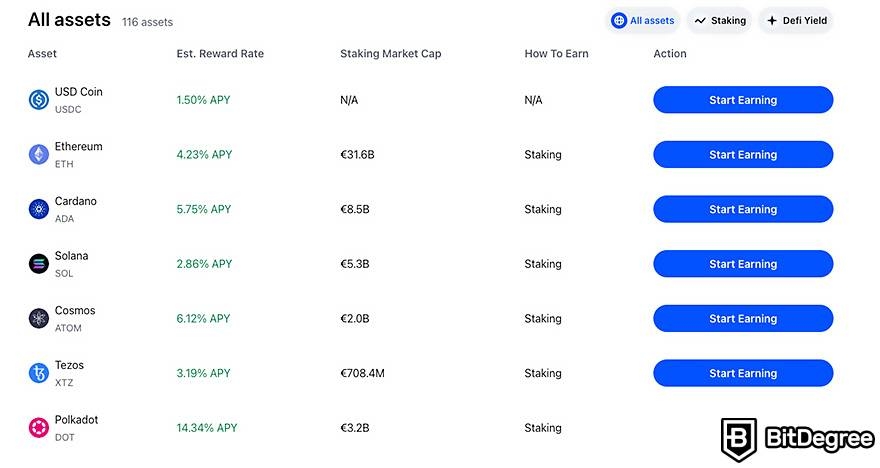
Then, you also need to observe the volatility of the coins’ price, because prices can significantly impact your staking rewards. Coins with higher volatility can result in higher potential earnings but also a higher risk of losing value. On the other hand, coins with lower volatility may offer more stable earnings but may have lower potential rewards.
Check out our cryptocurrency tracker to see trends in price fluctuations and other crucial information about the aforementioned assets, as well as other well-known cryptocurrencies.
Now, to give you an example, Solana (SOL) experienced a significant surge in price during the Summer of 2021, when its value more than tripled. However, by the end of 2022, SOL's price had retraced to levels comparable to early 2021, with the cryptocurrency trading at around $20.59 on March 26, 2023.
Investing in Solana in that Summer offered potentially high returns but also involved higher risks. It was a suitable choice for investors who were comfortable with taking bold moves, but not necessarily the best option for those seeking more conservative investments.
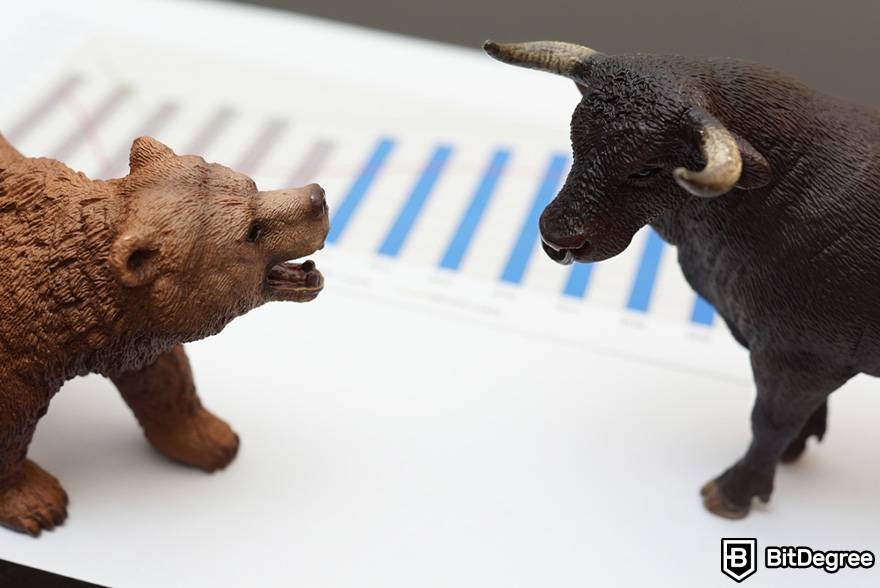
Moving further, note that you should always consider the reputation and adoption of the coins you plan to choose. Coins with a strong reputation and high adoption rates are more likely to be stable and have long-term potential, making them a safer option for staking. Since the crypto world poses a lot of risks overall, learning how to stake on Coinbase safely is crucial.
E.g., Ethereum (ETH) is widely considered to be one of the most established and reputable cryptocurrencies, with a large developer community and a wide range of use cases. It is also widely adopted, with many decentralized applications (dApps) and smart contracts built on its blockchain.
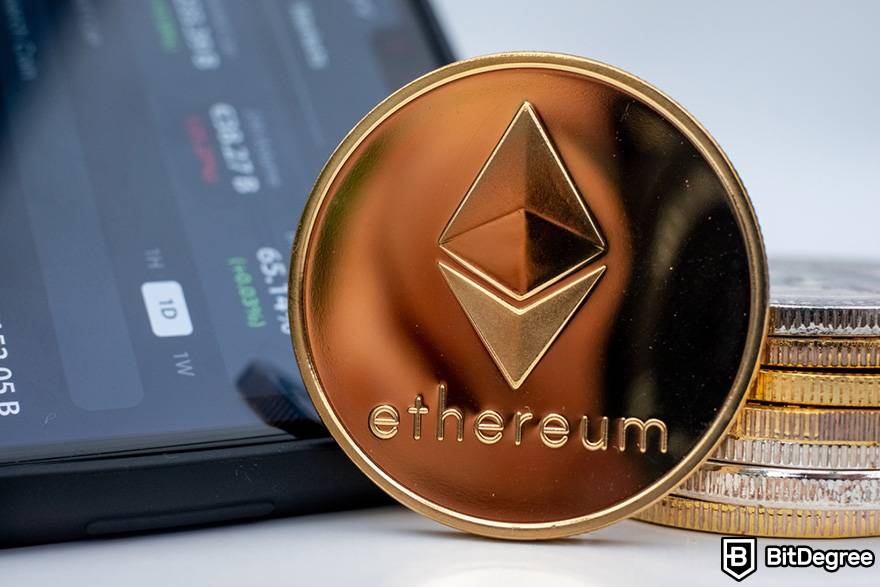
Finally, it's essential to consider any technical aspects of the coin, such as the security and scalability of the blockchain network. Coins with a more secure and scalable network are less likely to experience downtime or technical issues that could affect your staking rewards.
For instance, Solana (SOL) uses a unique Proof-of-History (PoH) consensus algorithm that allows for high scalability and fast transaction processing. It also has a high level of security, with regular security audits and bug bounties to ensure the network's integrity.
So, considering all the aforementioned factors, you now know how to correctly choose the right coin you can stake on Coinbase and maximize your Coinbase staking rewards.
Just don’t forget that it's essential to DYOR and stay up-to-date on any changes that may be imposed on the cryptocurrency you plan to stake. Keeping up with the latest news and trends in the cryptocurrency market will surely help you make more informed decisions and stay ahead of the game.
How to Stake on Coinbase?
Now that you've selected the right coin, it's time to learn how to stake on Coinbase. Fortunately, the process is very simple and can be done in just a few steps. By following this guide, you'll be able to start earning passive income from your cryptocurrency holdings in no time!
To put it shortly, all you’ll need to do is make sure you have a Coinbase account and have completed any necessary verification steps. If you don't have an account yet, you can sign up for one on the Coinbase website or mobile app. Once you're all set up, deposit your chosen cryptocurrency into your Coinbase wallet and opt-in to staking.
However, there’s one more question you need to ask yourself before starting your staking journey on Coinbase – do I comply with the minimum requirements?
Minimum Requirements for Staking on Coinbase
For starters, as you already know, cryptocurrencies have their own minimum staking requirements on Coinbase. Therefore, make sure that you have at least a minimum amount of the currency you want to stake and keep it in your Coinbase wallet for a required amount of time!
Moreover, to get Coinbase staking rewards, you must have your identity verified. To verify your identity, simply start the process of buying any cryptocurrency. Then, Coinbase will ask you for all relevant information according to your country or region.

Besides that, you must also check if your region is eligible for staking. The list of eligible regions for staking as of writing includes, but is not limited to: the United States (excluding some regions), Canada, Lithuania, Denmark, Czech Republic, Angola, South Africa, South Korea, Hong Kong, Lebanon, Australia, Brazil, Argentina, and others.
Though, some regions might have restrictions regarding a specific coin. For example, while Norway is a country where staking on Coinbase is available, it is not eligible for ETH2 rewards as of March 2023.
So, these are the main requirements you have to consider beforehand. Now, let’s get to the detailed guide on how to stake on Coinbase!

- Secure and reliable
- Accepts fiat currencies
- Lots of trading options
- Reputable exchange
- Accepts fiat currencies
- Offers various trading options

- Huge trading variety
- Regulation-compliant around the globe
- Fair trading fees
- Beginner-friendly
- A wide array of features
- Vast number of different crypto coins & tokens

- Beginner-friendly
- Secure
- Decent trading and withdrawal fees
- Crypto.com Visa Card
- Automated tools & bots
- Ecosystem synergy with CRO
Step-By-Step Guide on How to Stake on Coinbase
In order to start staking your assets on Coinbase, simply follow these steps:
- Create a Coinbase account and complete any necessary verification steps. Remember to create a strong password, as you should do with any bank or cryptocurrency-related security system! If you already have a Coinbase account, though, simply log in.
- Get your identity verified. To do so, just click 'Buy & Sell.' Doing that will prompt the Coinbase platform to show you a pop-up where you just need to input your information – the process is extremely simple.
- Deposit the cryptocurrency you want to stake into your Coinbase wallet. This can be done in multiple ways:
- you can transfer funds from another crypto wallet;
- you can deposit cash and buy tokens with it;
- you can exchange other coins you already have in your Coinbase wallet.
- From the 'Home' page, or by selecting the 'My assets' tab, click on the cryptocurrency you want to stake (for instance, let’s take ETH). By doing that, you’ll enter the selected currency’s detail page.
- In the asset’s detail page, scroll down and select "Earn on ETH" (or “Earn on” followed by the coin you chose). Review the staking details carefully and select 'Continue.'
- Enter the amount of tokens you want to stake. If you want to stake your entire balance, just select 'Max.' After that, be sure to select 'Preview stake.' On the preview screen, take your time to review all the operation details. Then, simply select 'Stake now.'
- Check your email. You should’ve received a confirmation email from Coinbase.
- Now, sit back and relax as Coinbase staking rewards flow into your earning balance. They will appear as transactions. Pretty easy, right?
In case you want to modify your staked balance or completely unstake your assets, you just need to return to the asset detail page and choose what you want to do. You may also manage staking operations and learn about your earnings by selecting the 'Earn' tab.

Overall, staking on cryptocurrency platforms such as Coinbase can be a smart move for investors looking to put their assets to work. You can easily optimize your earnings by following the steps provided in this guide.
Just don't forget to take into account elements like staking requirements, potential rewards, volatility, reputation, and technical aspects.
Now, when talking about how to stake on Coinbase, it’s also important to talk about Coinbase Pro.
What About Coinbase Pro Staking?
Coinbase Pro staking must be mentioned in this "how to stake on Coinbase" guide because it is what many stakers are used to when it comes to staking their assets on Coinbase. Coinbase Pro is a platform made specifically for advanced traders.
However, many customers also use the main Coinbase platform and the Coinbase app for advanced crypto features like staking, borrowing, and so on. This leads to friction when transferring balances between the two products, which prompted Coinbase to integrate Coinbase Pro staking functionalities into the main Coinbase platform.
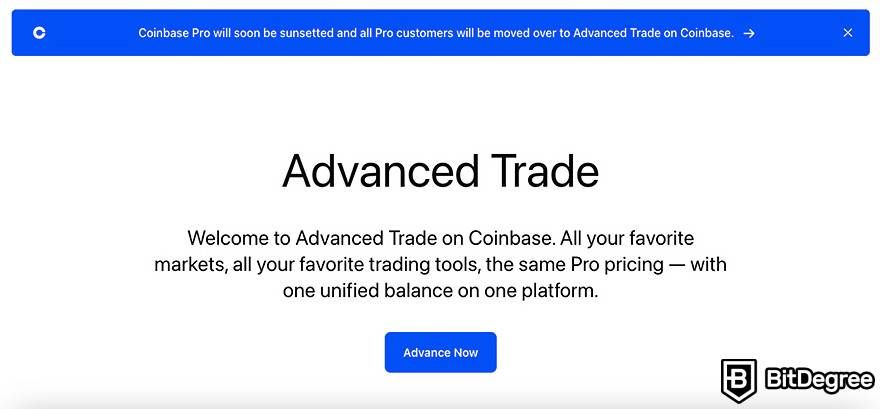
As a result, Coinbase Pro staking will soon become unavailable. However, users can still stake their assets on Coinbase using the staking options available on the main platform. To provide a seamless transition for advanced Coinbase Pro traders, Coinbase has launched the Advanced Trade feature.
Advanced Trade offers in-depth technical analysis, real-time order books, charting powered by TradingView, and improved order flows to make it easier and faster to place market, limit, or stop limit orders directly on the Coinbase exchange.
Advanced Trade also offers additional security features like 24/7 monitored cold storage facilities, USD held at FDIC-insured institutions, YubiKey for mobile, and vaults. Traders can access rewards to earn up to 7% APY on eligible crypto balances like USDC and staked ETH (ETH2), all within a single account balance.
Overall, Coinbase plans to continue improving Advanced Trade, adding features like mobile stop limit orders, additional charting and order form upgrades, full REST API & WebSocket support, etc. So, forget Coinbase Pro staking and get used to Coinbase Advanced Trade staking.
Risks and Rewards of Staking on Coinbase
Since you’ve already followed all the steps and know how to stake on Coinbase, the time has come for us to discuss the risks and rewards of staking.
One of the main rewards of Coinbase staking is the ability to earn additional cryptocurrency without having to do much work. Thus, Coinbase staking rewards allow you to easily grow your portfolio by having a relatively steady stream of income.
Another reward of using Coinbase as your staking platform is not having to worry about setting up your own nodes or complicated staking processes. Coinbase makes staking easy and accessible to anyone, even beginners.
In addition to these rewards, staking on Coinbase can also offer other benefits such as lower transaction fees and priority access to new coins and features. This can be especially valuable for traders and investors who want to stay ahead of the curve and take advantage of new opportunities as they arise.

Of course, like with any investment, staking always comes with some risks. The main risk is price volatility, which can lead to fluctuations in the value of your staked coins. However, if you choose the right coins and hold them for the long term, you may be able to mitigate this risk and earn significant returns over time.
Another staking risk is suffering losses due to slashing. Slashing is a penalty enforced by protocols because of network or validator failures. On the plus side, Coinbase has taken all possible measures to mitigate this risk, so you should feel safer staking on Coinbase.
Overall, the rewards of using Coinbase to stake your assets are worth it. With its ease of use, accessibility, and potential for steady passive income, Coinbase staking is surely a great way to grow your cryptocurrency holdings.
Conclusions
So, now you know how to stake on Coinbase! If you follow this guide and comply with all the requirements imposed by Coinbase, you'll have no problems in your staking journey. Just create an account, verify your identity, deposit the coins you want to stake, and start staking!
Though, always remember to take your time and do your own research when choosing the right coin. First, you must make sure that the coin you want to stake can be staked on Coinbase. Then, also check if the staking requirements are suitable for you.
Besides, apart from keeping in mind the potential rewards of using Coinbase to stake your crypto assets (which are definitely appealing), don’t forget staking risks.
Additionally, if you're interested in other platforms that are great for staking, check out this article!
Now, since we got over the "how to stake on Coinbase" and "why should you stake on Coinbase" parts, it's time for you to put everything into practice and start earning passive income from your crypto holdings. Happy staking!
The content published on this website is not aimed to give any kind of financial, investment, trading, or any other form of advice. BitDegree.org does not endorse or suggest you to buy, sell or hold any kind of cryptocurrency. Before making financial investment decisions, do consult your financial advisor.
